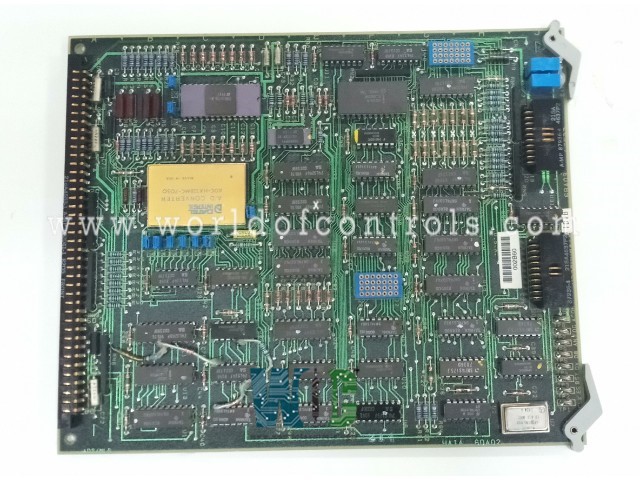
World Of Controls understands the criticality of your requirement and works towards reducing the lead time as much as possible.
DS3800HAIA1E - Analog Converter Card is available in stock which ships the same day.
DS3800HAIA1E - Analog Converter Card comes in UNUSED as well as REBUILT condition.
To avail our best deals for DS3800HAIA1E - Analog Converter Card, contact us and we will get back to you within 24 hours.
SPECIFICATIONS:
Part Number: DS3800HAIA1E
Manufacturer: General Electric
Series: Mark IV
Product Type: Analog Converter Card
Input Type: Analog
Input Signal Range: ±10 VDC
Input Channels: 8, 12, or 16
Analog-to-Digital Converter: 12-bit
Resolution: ±10 V
Sampling Rate: 10–50 ms
Mounting: Rack-mounted
Board Size: 15.7 cm High x 18.5 cm
Operating Temperature: 0°C to +60°C
Repair: 3-7 Days
Weight: 1.00 lbs
Country of Origin: USA
Availability: In Stock
FUNCTIONAL DESCRIPTION:
DS3800HAIA1E is an Analog Converter Card manufactured and designed by General Electric as part of the Mark IV Series used in GE Speedtronic Gas turbine control systems. The Analog Converter Card is a critical component used in industrial control systems, primarily responsible for converting analog signals (such as voltage or current) from sensors or other field devices into a digital signal readable by a control processor (such as a PLC or turbine controller). These cards ensure accurate representation of real-world process variables like temperature, pressure, and flow within the control system. Depending on the design, the card may support multiple input types (e.g., 0–10V, 4–20mA) and channels, providing high-resolution analog-to-digital conversion. It often includes onboard signal conditioning circuits for filtering, isolation, and amplification to maintain signal integrity even in electrically noisy environments.
INSTALLATION:
The card is designed to be inserted into a dedicated I/O slot within the control rack or module bay of the respective Speedtronic system. Carefully align the gold-plated edge connector of the card with the mating female connector on the backplane. Apply uniform pressure to seat the card fully into the connector without tilting, rocking, or using excessive force. The card should lock securely into position using the captive screws or latching mechanisms provided on the rack frame.
Input wiring from field analog sources such as RTDs, thermocouples, pressure transducers, or current transmitters must be connected to the appropriate terminal strip or pluggable connector associated with the Analog Converter Card. In GE systems, these often terminate at the Terminal Boards (TBQA, TBQB, or TBCC) or through ribbon cables, depending on the system design. Ensure correct channel allocation, polarity, and loop integrity, especially for 4–20mA signals, which may require loop-powered configurations.
OPERATION:
The GE Analog Converter Card is responsible for receiving, conditioning, and digitizing analog input signals from various field devices such as thermocouples, RTDs, pressure transmitters, and other analog instrumentation within gas or steam turbine control systems. Once installed and configured, the card operates as a key interface between the physical process and the turbine control processor.
Each input signal passes through onboard signal conditioning circuits, which may include amplification, cold junction compensation (for thermocouple inputs), filtering (to eliminate noise and high-frequency transients), and isolation barriers to protect the control system from electrical disturbances and ground loops.
Following signal conditioning, the analog input is converted to a digital representation using a high-resolution Analog-to-Digital Converter (ADC). These ADCs typically offer resolutions of 12 to 16 bits, allowing for precise measurement of process variables. The digital output is then transferred over the system backplane to the core control processor (R, S, and T) cores in Mark V for use in control logic, alarms, and data logging.
GE Analog Converter Cards support multiple channels and may operate in differential or single-ended modes, depending on the configuration. Each channel is typically scanned cyclically according to the control system's sampling rate, often in the range of 10–100 milliseconds, ensuring real-time process monitoring.
WOC (World of Controls) offers the largest inventory of replacement parts for the GE Speedtronic Mark IV control system, including new, surplus, and expertly refurbished boards, all backed by a reliable warranty. Every component undergoes thorough testing to ensure optimal performance and compatibility. In addition to part supply, we provide specialized repair services for faulty boards, restoring them to OEM standards using advanced diagnostics and repair procedures.
Our team of experienced engineers is available 24/7 to support your OEM and automation needs, including part identification, technical guidance, and real-time troubleshooting. Whether you're looking for immediate part availability, cost-effective repairs, or expert advice, WOC is your trusted partner. For inquiries related to pricing, stock status, or repair services, contact us via phone, email, or our website. we're here to help keep your systems running efficiently.
What is the function of the Analog Converter Card in the GE Mark IV system?
The Analog Converter Card receives analog input signals (4–20mA, 0–5V, thermocouple, or RTD) from field instruments and converts them into digital signals. These are then processed by the Mark IV control system for monitoring and control of turbine parameters.
How are analog inputs isolated and conditioned on the card?
Each input channel is typically routed through input isolation amplifiers, followed by low-pass filters to attenuate high-frequency noise. In some models, opto-isolation or transformer-based isolation ensures protection from field-level transients and ground potential differences.
How is the Analog Converter Card initialized at power-up?
During boot-up, the controller performs a self-test sequence, validating card identification, input path integrity, and ADC readiness. The system polls the Analog Converter Card for a digital handshake signal, confirming its operational readiness before engaging the control logic.